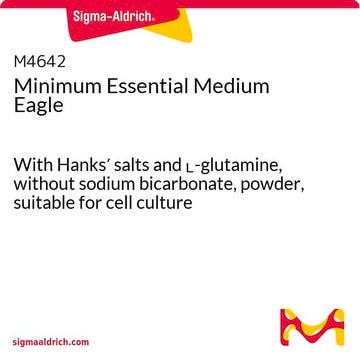M3024
Meio mínimo essencial de Eagle
with Earle′s salts and non-essential amino acids, without L-glutamine, phenol red and sodium bicarbonate, Modified, powder, suitable for cell culture
Sinônimo(s):
MEM
About This Item
Produtos recomendados
Nível de qualidade
forma
powder
técnica(s)
cell culture | mammalian: suitable
componentes
Earle’s salts (5% CO2): yes
L-glutamine: no
HEPES: no
NaHCO3: no
sodium pyruvate: no
phenol red: no
Condições de expedição
ambient
temperatura de armazenamento
2-8°C
Procurando produtos similares? Visita Guia de comparação de produtos
Categorias relacionadas
Descrição geral
Aplicação
- to culture endometrial adenocarcinoma Ishikawa cells for bisphenol studies
- to culture MCF-7 cells for experimental treatments with hormone
- to maintain zebrafish pineal glands for action spectrum analysis
Características e benefícios
Quantidade
Reconstituição
geralmente comprado junto com este produto
Código de classe de armazenamento
13 - Non Combustible Solids
Classe de risco de água (WGK)
WGK 1
Ponto de fulgor (°F)
Not applicable
Ponto de fulgor (°C)
Not applicable
Certificados de análise (COA)
Busque Certificados de análise (COA) digitando o Número do Lote do produto. Os números de lote e remessa podem ser encontrados no rótulo de um produto após a palavra “Lot” ou “Batch”.
Já possui este produto?
Encontre a documentação dos produtos que você adquiriu recentemente na biblioteca de documentos.
Os clientes também visualizaram
Artigos
A large selection of MEM formulations. Minimum Essential Medium (MEM), developed by Harry Eagle, is one of the most widely used of all synthetic cell culture media.
Protocolos
Powdered media and salt mixtures are extremely hygroscopic and should be protected from atmospheric moisture.
Nossa equipe de cientistas tem experiência em todas as áreas de pesquisa, incluindo Life Sciences, ciência de materiais, síntese química, cromatografia, química analítica e muitas outras.
Entre em contato com a assistência técnica



